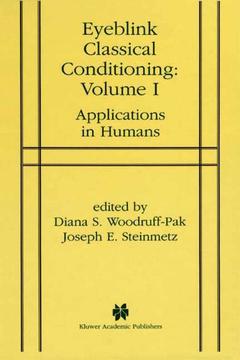Description
Eyeblink Classical Conditioning Volume 1, 2002
Applications in Humans
Coordinators: Woodruff-Pak Diana S., Steinmetz Joseph E.
Language: English
Subject for Eyeblink Classical Conditioning Volume 1:
Eyeblink Classical Conditioning Volume 1
Publication date: 12-2010
318 p. · 15.5x23.5 cm · Paperback
Publication date: 12-2010
318 p. · 15.5x23.5 cm · Paperback
Eyeblink classical conditioning: volume 1
Publication date: 02-2000
318 p. · 15.5x23.5 cm
Publication date: 02-2000
318 p. · 15.5x23.5 cm
Description
/li>Contents
/li>
The model system of eyeblink classical conditioning in humans has enormous potential for the understanding and application of fundamental principles of learning. This collection makes classical conditioning accessible to teachers and researchers in a number of ways. The first aim is to present the latest developments in theory building. Second, as background for the current directions, Eyeblink Classical Conditioning, Volume I presents an overview of a large body of previously published research on eyeblink classical conditioning. Last, the authors describe eyeblink classical conditioning techniques. Each chapter includes a highlighted methods section so that interested readers can replicate techniques for teaching and research.
List of Contributors. Overview and Background. 1. Past, Present, and Future of Human Eyeblink Classical Conditioning; D.S. Woodruff-Pak, J.E. Steinmetz. 2. Neural Network Approaches to Classical Conditioning; N.A. Schmajuk. Cognitive Neuroscience Approaches to Eyeblink Conditioning in Normal Adults. 3. Functional Networks Underlying Human Eyeblink Conditioning; A.R. McIntosh, B.G. Schreurs. 4. Functional MRI Studies of Eyeblink Classical Conditioning; S.K. Lemieux, D.S. Woodruff-Pak. 5. Dual-Task and Repeated Measures Designs: Utility in Assessing Timing and Neural Functions in Eyeblink Conditioning; J.T. Green, et al. Eyeblink Conditioning Over the Life Span. 6. Using Eyeblink Conditioning to Assess Neurocognitive Development in Human Infants; D. Ivkovich, et al. 7. Classical Eyeblink Conditioning in Normal and Autistic Children; L.L. Sears, J.E. Steinmetz. 8. Human Eyeblink Classical Conditioning in Normal Aging and Alzheimer's Disease; D.S. Woodruff-Pak. Contributions of Abnormal Groups to Theoretical and Empirical Understanding. 9. Eyeblink Conditioning in Neurological Patients with Motor Impairments; M.M. Schugens, et al. 10. Eyeblink Classical Conditioning in Amnesia; R. McGlinchey-Berroth. 11. Awareness and the Conditioned Eyeblink Response; R.E. Clark, L.R. Squire. 12. Can Eyeblink Classical Conditioning Provide a Foundation for Integrating Clinical Science and Cognitive Neuroscience in the Study of Psychopathology? R.M. McFall, et al. Appendix: Bibliographyof Human Eyeblink Conditioning; I. Gormezano. Index.
© 2024 LAVOISIER S.A.S.




